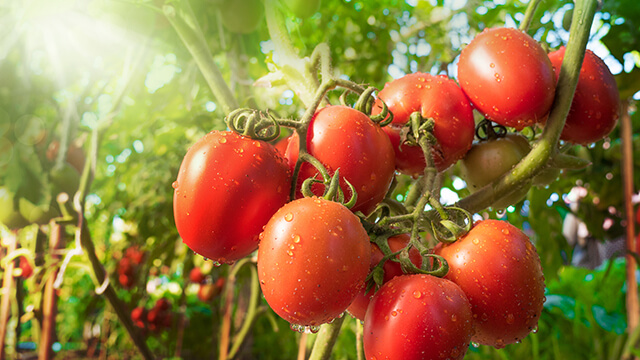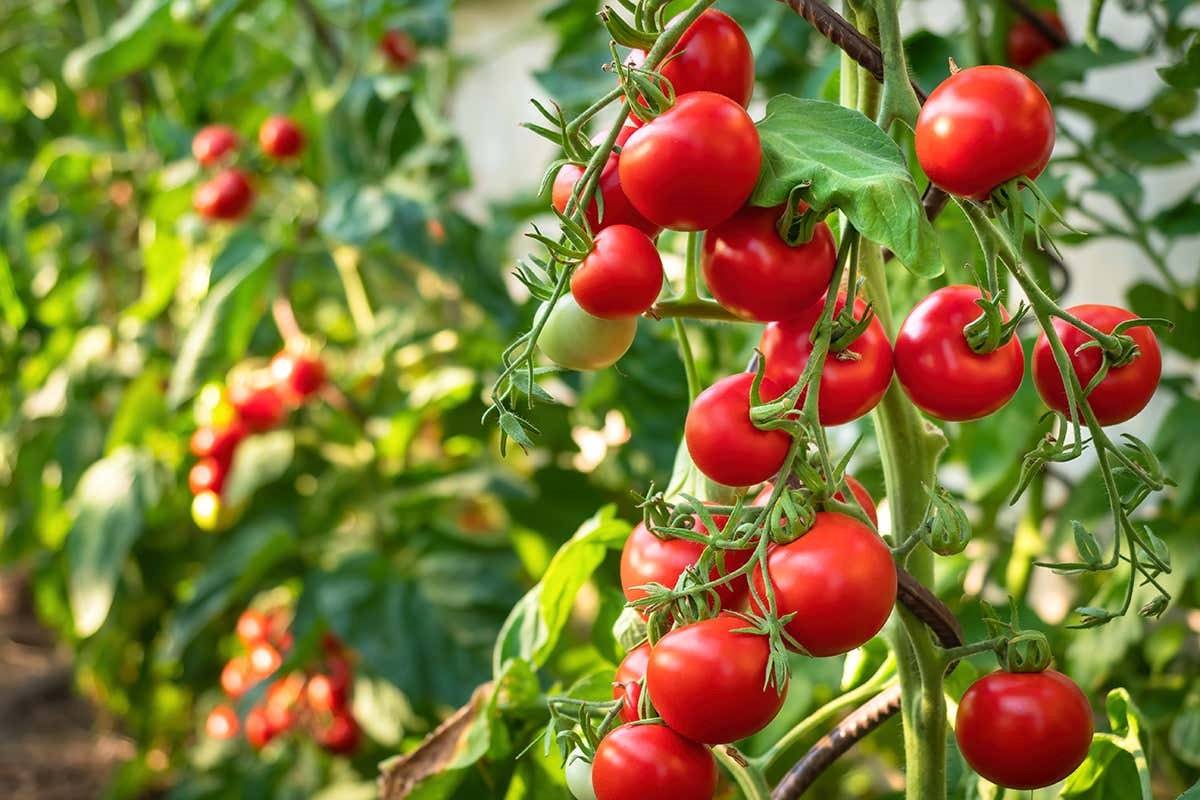12 Tomato Growth Hacks for a High Yield Harvest | Expert Tips
12 Tomato Growth Hacks for a High Yield Harvest | Expert Tips
Tomatoes are one of the most popular vegetables in the world and for a good reason. They are nutritious, delicious, and easy to grow. With a few simple tips and tricks, you can have a bountiful harvest of juicy, ripe tomatoes in no time.
Choose the Right Varieties
There are many different varieties of tomatoes to choose from, each with its own unique characteristics. Some are better suited to cooler climates, while others prefer warmer temperatures. Choose a variety that is well-suited to your growing conditions to ensure the best possible results.
Start with Healthy Seedlings
Starting your tomatoes from seedlings is a great way to get a head start on the growing season. Look for healthy seedlings with thick stems and bright green leaves. Avoid plants that are wilted or yellowed, as these may have underlying health issues that can stunt growth and reduce yields.
Plant in a Sunny Location
Tomatoes require plenty of sunshine to grow and thrive. Choose a location that receives at least 6-8 hours of direct sunlight per day for best results. Avoid planting in shady or damp areas, as this can lead to disease and poor growth.

Provide Adequate Watering
Tomatoes require consistent watering to produce healthy fruit. Aim to water deeply once per week, or more frequently in hot, dry weather. Avoid overhead watering, as this can promote disease and reduce yields.
Use High-Quality Soil
Tomatoes require rich, well-draining soil to grow and thrive. Mix in plenty of compost or organic matter to improve soil quality and fertility. Avoid planting in heavy clay or sandy soils, as these can lead to poor growth and yields.
Use Fertilizer Sparingly
While tomatoes require plenty of nutrients to grow and produce fruit, it's important not to over-fertilize. Use a balanced fertilizer with a 10-10-10 or similar N-P-K ratio, and apply sparingly. Too much fertilizer can lead to excessive vegetative growth and reduced yields.
Prune for Better Yields
Pruning your tomato plants can help improve air circulation, reduce disease, and promote better fruit set. Remove any suckers that form in the crotch between the stem and branches, as these can divert energy away from fruit production. Also, remove any yellow or diseased leaves as soon as they appear.
Support Your Plants
Tomatoes are heavy feeders and require support to keep their fruit off the ground. Use stakes, cages, or trellises to support your plants and keep fruit from touching the soil. This will help reduce disease and improve yields.

Watch for Pests and Diseases
Tomatoes are susceptible to a wide range of pests and diseases, including aphids, whiteflies, and blight. Monitor your plants regularly and take action as soon as you notice any signs of trouble. Use organic pest control methods whenever possible, such as neem oil or insecticidal soap.
Harvest at the Right Time
Tomatoes are ready to harvest when they are firm, full-colored, and slightly soft to the touch. Avoid picking them too early, as this can reduce flavor and quality. Harvest regularly to encourage continued fruit production throughout the growing season.
Store Tomatoes Properly
Tomatoes should be stored at room temperature, away from direct sunlight. Avoid storing them in the refrigerator, as this can reduce flavor and texture.
Consider Companion Planting
Companion planting is the practice of growing certain plants together to improve growth and repel pests. Consider planting basil, marigolds, or garlic alongside your tomatoes to help repel pests and improve growth.

Monitor Soil Moisture
Tomatoes require consistent moisture to grow and produce fruit. Monitor soil moisture levels regularly and adjust watering as needed. Avoid over-watering, as this can lead to disease and poor growth.
Use Mulch
Mulch can help conserve moisture, suppress weeds, and regulate soil temperature. Use organic mulch, such as straw, leaves, or grass clippings, to improve soil health and fertility.
Consider Container Gardening
If you don't have space for a traditional garden, consider growing tomatoes in containers. Choose a large pot with good drainage, and use high-quality soil and fertilizer to ensure the best possible results.
Rotate Your Crops
Rotating your crops can help prevent soil-borne diseases and improve soil health. Avoid planting tomatoes in the same spot year after year, and consider planting cover crops, such as clover or rye, to improve soil fertility.
Consider Growing Heirloom Varieties
Heirloom tomatoes are varieties that have been passed down through generations, often with unique flavor and appearance characteristics. Consider growing heirloom varieties to add variety to your harvest and enjoy unique flavors.
Use Organic Pest Control Methods
Tomatoes can be susceptible to a wide range of pests and diseases. Use organic pest control methods whenever possible, such as neem oil or insecticidal soap. Avoid using chemical pesticides, as these can harm beneficial insects and lead to pesticide resistance.
Don't Overcrowd Your Plants
Tomatoes require plenty of space to grow and produce fruit. Avoid overcrowding your plants, as this can lead to poor growth and reduced yields. Space plants at least 2-3 feet apart to allow for proper air circulation and growth.
Be Patient
Growing tomatoes takes time and patience. Don't be discouraged if you encounter setbacks or challenges along the way. With the right care and attention, you can produce a bountiful harvest of delicious, ripe tomatoes.
Tomatoes are a popular crop for home gardeners, but they can be susceptible to a wide range of pests and diseases. Here are some common tomato pests and diseases, as well as organic control methods to help you protect your crop:
_1677328072.jpg)
1.Aphids
Aphids are small, soft-bodied insects that suck the sap from tomato plants, causing stunted growth and yellowing leaves. Control aphids by spraying plants with a strong stream of water, or using insecticidal soap or neem oil.
2.Tomato Hornworms
Tomato hornworms are large, green caterpillars that can quickly defoliate tomato plants. Look for the distinctive white eggs of the parasitic wasp, which can help control hornworm populations. Handpick and remove any hornworms you find, or use an organic pesticide containing Bacillus thuringiensis (BT).
3.Early Blight
Early blight is a fungal disease that causes brown spots on tomato leaves and stems, eventually leading to defoliation and reduced yields. Control early blight by removing infected plant material and improving air circulation around plants. Use copper fungicide or sulfur dust as a preventive measure.
4.Blossom End Rot
Blossom end rot is a physiological disorder caused by a calcium deficiency in the plant. It appears as a dark, sunken spot on the bottom of the tomato fruit. Control blossom end rot by maintaining consistent moisture levels and adding calcium to the soil before planting.
5. Septoria Leaf Spot
Septoria leaf spot is another fungal disease that causes brown spots on tomato leaves, eventually leading to defoliation and reduced yields. Control septoria leaf spot by removing infected plant material and improving air circulation around plants. Use copper fungicide or sulfur dust as a preventive measure.
6.Whiteflies
Whiteflies are small, white insects that suck the sap from tomato plants, causing stunted growth and yellowing leaves. Control whiteflies by spraying plants with a strong stream of water, or using insecticidal soap or neem oil.
7. Late Blight
Late blight is a fungal disease that can quickly devastate tomato plants. It causes brown spots on leaves and stems, and can lead to rapid defoliation and fruit rot. Control late blight by removing infected plant material and improving air circulation around plants. Use copper fungicide or sulfur dust as a preventive measure.
By using these organic control methods, you can help protect your tomato crop from common pests and diseases, ensuring a bountiful harvest of healthy, delicious tomatoes.
Agribegri offers a wide range of products that can help you fix common tomato pests and diseases. Here are a few products that I would recommend:

1. Neem Oil
Neem oil is a natural insecticide and fungicide that can help control a wide range of tomato pests and diseases, including aphids, whiteflies, and powdery mildew. It works by disrupting the pest's feeding and reproductive cycles. Agribegri offers several brands of neem oil in various sizes.
2. Bacillus Thuringiensis (BT)
BT is a natural pesticide that targets specific caterpillar pests, such as tomato hornworms. It works by releasing toxins that are lethal to the caterpillars, but harmless to humans, pets, and beneficial insects. Agribegri offers several brands of BT in various sizes.
3. Copper Fungicide
Copper fungicide is a natural fungicide that can help control early and late blight, as well as other fungal diseases. It works by inhibiting fungal spore germination and growth. Agribegri offers several brands of copper fungicide in various sizes.
4. Calcium Nitrate
Calcium nitrate is a water-soluble fertilizer that can help prevent blossom end rot by providing the necessary calcium for healthy fruit development. It can also help improve overall plant health and vigor. Agribegri offers several brands of calcium nitrate in various sizes.
Buy Now Button
Buy Now
FAQ
Frequently Asked Questions on Tomato Growth Hacks for a High Yield Harvest:
Select a question: -- Select --Q: How often should I water my tomato plants?Q: How can I prevent tomato diseases and pests?Q: How can I encourage more fruit production from my tomato plants?
Posted
2 years ago
No comments yet! Why don't you be the first?












_1677328072.jpg)

Add a comment